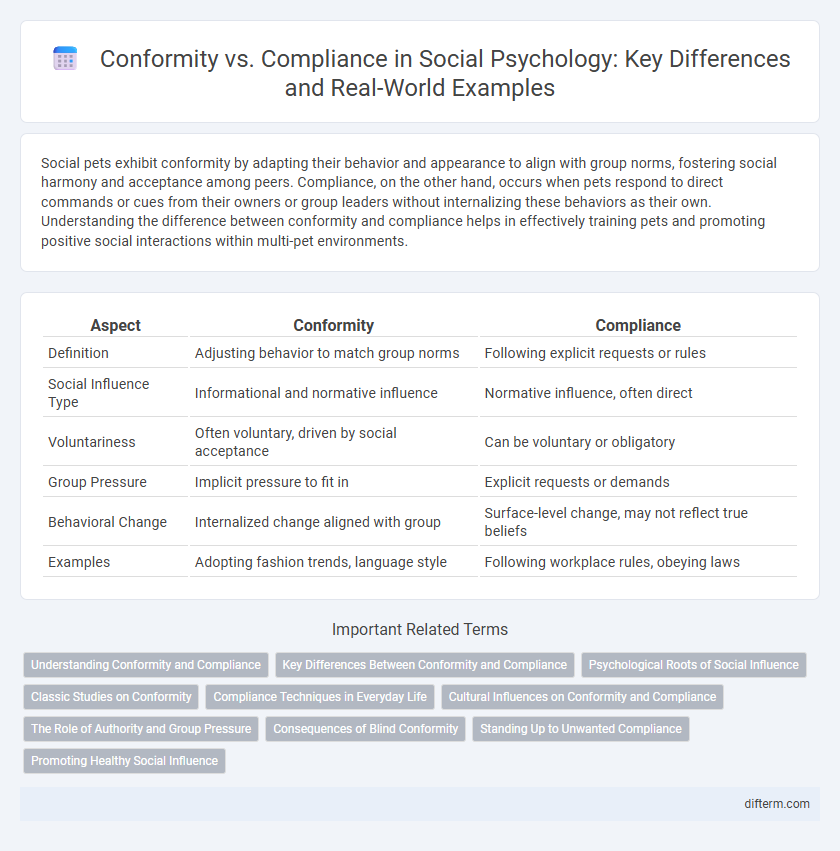Social pets exhibit conformity by adapting their behavior and appearance to align with group norms, fostering social harmony and acceptance among peers. Compliance, on the other hand, occurs when pets respond to direct commands or cues from their owners or group leaders without internalizing these behaviors as their own. Understanding the difference between conformity and compliance helps in effectively training pets and promoting positive social interactions within multi-pet environments.
Table of Comparison
| Aspect | Conformity | Compliance |
|---|---|---|
| Definition | Adjusting behavior to match group norms | Following explicit requests or rules |
| Social Influence Type | Informational and normative influence | Normative influence, often direct |
| Voluntariness | Often voluntary, driven by social acceptance | Can be voluntary or obligatory |
| Group Pressure | Implicit pressure to fit in | Explicit requests or demands |
| Behavioral Change | Internalized change aligned with group | Surface-level change, may not reflect true beliefs |
| Examples | Adopting fashion trends, language style | Following workplace rules, obeying laws |
Understanding Conformity and Compliance
Conformity involves changing behaviors or beliefs to match group norms driven by social pressure, often unconsciously aligning with majority opinion. Compliance refers to yielding to explicit requests or demands from others, typically motivated by the desire for reward or avoidance of punishment. Understanding the subtle psychological mechanisms behind both conformity and compliance reveals their critical roles in shaping social interactions and group dynamics.
Key Differences Between Conformity and Compliance
Conformity involves changing one's behavior or beliefs to match those of a group due to perceived social pressure, emphasizing internal acceptance of group norms. Compliance refers to publicly obeying a request or rule from an authority figure without necessarily agreeing internally, highlighting external adherence. The key difference lies in conformity's internal influence on attitudes, while compliance centers on outward behavior motivated by external demands.
Psychological Roots of Social Influence
Conformity and compliance stem from distinct psychological roots within social influence, where conformity arises from the innate human desire to belong and avoid social rejection, often leading individuals to align their attitudes and behaviors with group norms. Compliance, conversely, is driven by external pressures and the anticipation of rewards or punishments, compelling individuals to respond favorably to explicit requests or demands despite personal beliefs. Understanding these mechanisms highlights how social influence operates through both internalized acceptance and strategic adaptation to social expectations.
Classic Studies on Conformity
Classic studies on conformity, such as Solomon Asch's 1951 experiments, demonstrate how individuals often conform to group norms to avoid social rejection despite personal disagreement. These studies reveal the powerful influence of majority opinion on behavior, highlighting normative social influence as a key driver of conformity. The distinction between conformity and compliance is evident as conformity involves internalizing group norms, whereas compliance occurs through external pressure without genuine agreement.
Compliance Techniques in Everyday Life
Compliance techniques in everyday life include foot-in-the-door, door-in-the-face, and low-ball strategies that influence individuals to agree to requests or follow rules without overt pressure. The foot-in-the-door technique involves securing agreement to a small request before making a larger one, increasing the likelihood of compliance. These methods leverage psychological principles like commitment, reciprocity, and consistency, shaping social behavior through subtle persuasion rather than direct authority.
Cultural Influences on Conformity and Compliance
Cultural influences significantly shape conformity and compliance by molding social norms and expectations within societies. Collectivist cultures tend to exhibit higher conformity rates due to the emphasis on group harmony and interdependence, while individualistic cultures prioritize personal autonomy, often resulting in lower compliance levels. Understanding these cultural dimensions is crucial for analyzing behavior patterns in diverse social contexts.
The Role of Authority and Group Pressure
Authority figures and group pressure significantly influence conformity and compliance by shaping individuals' behavior to align with social norms and expectations. Studies show that people are more likely to comply with requests from perceived authoritative figures due to a psychological drive for obedience and fear of sanctions. Group pressure intensifies conformity as individuals seek acceptance and avoid social rejection, often leading to public compliance even when private beliefs differ.
Consequences of Blind Conformity
Blind conformity often leads to the erosion of individual critical thinking, resulting in decisions that perpetuate harmful social norms and unethical behaviors. It can create environments where dissent is discouraged, stifling innovation and promoting groupthink. This dynamic increases the risk of social injustice and systemic discrimination as people follow rules unquestioningly without evaluating their moral implications.
Standing Up to Unwanted Compliance
Standing up to unwanted compliance involves recognizing the pressures exerted by social conformity and asserting individual autonomy to resist unethical or unfair demands. Research in social psychology reveals that individuals who assertively refuse compliance can reduce the influence of group pressure and promote positive social change. Empowering people with strategies such as clear communication, setting boundaries, and seeking support enhances resilience against coercive compliance in various social settings.
Promoting Healthy Social Influence
Promoting healthy social influence requires understanding the difference between conformity and compliance, where conformity reflects genuine internal agreement while compliance involves outward behavior change without private acceptance. Encouraging authentic conformity leads to positive social norms and long-lasting behavioral shifts, enhancing group cohesion and well-being. Strategies that foster open dialogue and critical thinking reduce blind compliance, empowering individuals to align with socially beneficial values.
conformity vs compliance Infographic

 difterm.com
difterm.com